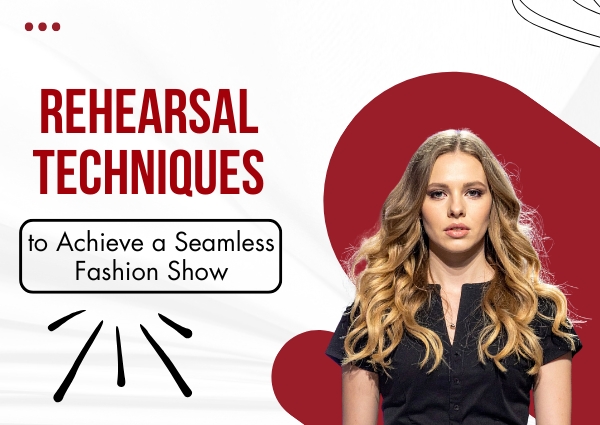Behind every glamorous fashion show is a whirlwind of preparation, discipline, and coordination. While the audience sees elegance, confidence, and perfection on the runway, what they don’t see are the countless hours of rehearsals that make it possible. A flawless fashion show isn’t just about stunning outfits—it’s about timing, precision, and flow.
At Babla Kathuria, we understand that rehearsals are the backbone of fashion choreography. In this blog, we’ll explore proven rehearsal techniques that help choreographers and teams deliver seamless, unforgettable fashion shows.
Why Rehearsals Matter in Fashion Shows
Fashion shows are high-stakes events. A small mistake—whether it’s a late model entrance, poor synchronization with lighting, or technical miscommunication—can disrupt the entire flow. Rehearsals:
- Ensure models are confident and runway-ready.
- Perfect the timing between music, lights, and movement.
- Minimize surprises on show day.
- Build teamwork and coordination among the entire crew.
Simply put, rehearsals turn creative ideas into a well-executed performance.
Key Rehearsal Techniques for a Seamless Show
- Walk Training and Consistency
The first step in rehearsal is ensuring models perfect their walk. Choreographers guide models on posture, stride, and expressions. Consistency is critical—every model must maintain the right pace to align with the designer’s vision and the show’s mood.
Pro Tip: Practice with the actual footwear and outfits when possible. Shoes, especially high heels, can impact balance, while heavy gowns may alter walking style.
- Marking the Stage
Choreographers often mark exact positions on the runway with tape or subtle indicators. These serve as reminders for models to pause, pose, or turn at the right moment. This technique is particularly helpful in shows with group walks or when models need to maintain specific distances.
Pro Tip: Rehearse with stage lighting in place to avoid surprises caused by shadows or bright spots.
- Timing with Music
Music is the heartbeat of a fashion show. Every step, turn, and pose must match the rhythm. Rehearsals involve practicing multiple times with the show’s soundtrack until movements flow naturally with the beats.
Pro Tip: Have backup tracks prepared in case of technical issues. Choreographers also train models to adapt if music cues shift slightly.
- Cue Synchronization with Lights and Props
In modern shows, lights, props, and even LED backdrops play a major role. During rehearsals, choreographers collaborate with the technical team to synchronize walk sequences with lighting changes, prop movements, or stage effects.
Pro Tip: Conduct full dress rehearsals with the technical crew to avoid last-minute coordination failures.
- Group Walks and Pairing Techniques
Fashion shows often feature models walking in pairs or groups. This requires extra practice to ensure spacing, timing, and symmetry. Choreographers use repeated drills to help models develop natural coordination with one another.
Pro Tip: Assign consistent walking partners for smoother chemistry and confidence on stage.
- Problem-Solving Drills
What if a model stumbles? What if a dress strap slips or a shoe breaks? Choreographers prepare for these scenarios by rehearsing problem-solving drills. Models are trained to handle wardrobe malfunctions gracefully and continue walking with confidence.
Pro Tip: Encourage models to practice maintaining composure even if something goes wrong—because the show must go on.
- Mirror Rehearsals for Expressions
A model’s walk is only half the story—their expression carries the designer’s vision. Rehearsals often include mirror practice sessions where models refine their facial expressions to match the show’s theme, whether it’s fierce, elegant, or playful.
Pro Tip: Record rehearsal videos so models can self-correct and improve.
- Full-Dress Rehearsals
The final stage of preparation is a complete run-through with all elements in place—wardrobe, music, lighting, props, and crew. This ensures everyone knows their role and builds confidence before the big day.
Pro Tip: Conduct at least two full-dress rehearsals—one for practice, another as a final confidence-building exercise.
Common Mistakes to Avoid During Rehearsals
- Skipping footwear practice – Models often rehearse in flats but perform in heels, leading to mishaps.
- Not timing breaks – Exhausted models may lose energy if rehearsal schedules are poorly managed.
- Over-rehearsing – While practice is essential, overdoing it can cause fatigue and reduce spontaneity.
- Ignoring technical rehearsals – Many shows fail due to overlooked sound or lighting missteps.
The Triumph of Seamless Execution
When rehearsals are conducted with discipline and creativity, the results are magical. Models glide effortlessly, music and lights blend harmoniously, and the audience experiences pure enchantment. For fashion choreographers, the ultimate triumph is watching everything come together flawlessly—the artistry of designers, the confidence of models, and the energy of the production team.
A successful fashion show is not built in one night—it is the product of thoughtful planning, disciplined rehearsals, and seamless teamwork. Techniques like stage marking, music synchronization, group walk drills, and full-dress rehearsals are the pillars of excellence.
At Babla Kathuria, we believe rehearsals are where fashion magic is truly created. By refining every detail before the spotlight shines, choreographers and teams ensure that what the audience sees is nothing short of perfection—a fashion story brought to life with elegance and confidence.

